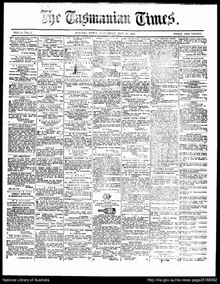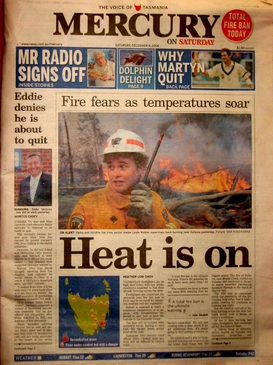
The Tasmanian Times was a newspaper published in Hobart, Tasmania, Australia. It was formerly known as the Evening Mail. [1] [2]

The Tasmanian Times was a newspaper published in Hobart, Tasmania, Australia. It was formerly known as the Evening Mail. [1] [2]
The newspaper was published from 1867 to 1870 by Donald Macmillan. [2] It was published tri-weekly on Tuesday, Thursday and Saturday mornings. It was a single sheet of double demy. It cost 3 shillings for a quarter year or one penny per issue. [3]
The newspaper has been digitised and is available on Trove. [4]

TheMercury is a daily newspaper, published in Hobart, Tasmania, Australia, by Davies Brothers Pty Ltd, a subsidiary of News Corp Australia, itself a subsidiary of News Corp. The weekend issues of the paper are called Mercury on Saturday and Sunday Tasmanian. The current editor of TheMercury is Craig Herbert.

The Tasmanian Government Railways (TGR) was the former operator of the mainline railways in Tasmania, Australia. Formed in 1872, the railway company was managed by the Government of Tasmania, and existed until absorption into the Australian National Railways Commission in 1978.

Hamilton is a rural locality in the local government area (LGA) of Central Highlands in the Central LGA region of Tasmania. The locality is about 73 kilometres (45 mi) north-west of the city of Hobart. The 2016 census recorded a population of 241 for the suburb of Hamilton.

The State Library of Tasmania is the reference, special collections, research and public lending library in the Tasmanian capital of Hobart, Australia. It is part of Libraries Tasmania. Libraries Tasmania includes a state-wide network of library services, community learning, adult literacy and the State’s archives and heritage services.
The Zeehan and Dundas Herald was a newspaper for the West Coast Tasmania community, based in Zeehan and Dundas from 1890 to 1922.
The Colonial Times was a newspaper in what is now the Australian state of Tasmania. It was established as the Colonial Times, and Tasmanian Advertiser in 1825 in Hobart, Van Diemen's Land by the former editor of the Hobart Town Gazette, and Van Diemen's Land Advertiser, Andrew Bent. The name was changed to Colonial Times in 1828. In 1857 the title was absorbed into the Hobart Town Mercury.
The Courier is a newspaper founded in 1827 in Hobart, Tasmania, as The Hobart Town Courier. It changed its name to The Hobart Town Courier and Van Diemen's Land Advertiser in 1839, settling on The Courier in 1840.
William Dodery was an Australian politician.

Franklin Square is a 1.6-acre (0.63-hectare) oak-lined public square located in the Hobart City Centre in Tasmania, Australia. It is named for Sir John Franklin, an Arctic explorer and former Lieutenant-Governor of Van Diemen's Land. The centrepiece of the park is a statue of Franklin, with an epitaph written by Alfred, Lord Tennyson. As the city's most central urban parkland and transportation hub, Franklin Square is frequently utilised for festive markets, public gatherings and as a place for public protest.

Henry Hunter (1832–1892) was a prominent architect and civil servant in Tasmania and Queensland, Australia. He is best known for his work on churches. During his life was also at various times a state magistrate of Tasmania, a member of the Tasmanian State Board of Education, the Hobart Board of Health, a Commissioner for the New Norfolk Insane Asylum and President of the Queensland Institute of Architects.

St Mary's Cathedral in Hobart, Tasmania, Australia, is the seat of the Roman Catholic Archbishop of Hobart, presently Julian Porteous.

Isle of the Dead is an island, about 1 hectare in area, adjacent to Port Arthur, Tasmania, Australia. It is historically significant since it retains an Aboriginal coastal shell midden, one of the first recorded sea-level benchmarks, and one of the few preserved Australian convict-period burial grounds. The Isle of the Dead occupies part of the Port Arthur Historic Site, is part of Australian Convict Sites and is listed as a World Heritage Property because it represents convictism in the era of British colonisation.

The Independent was a weekly English language newspaper published in Launceston, Tasmania from 1831 to 1835.

William Bannon was an Irishman who served in the British 65th Regiment of Foot in the New Zealand Wars in the 1840s. In 1849 he was found guilty of desertion and theft and was sentenced to transportation for seven years to Van Diemen's Land. A reward was posted for Bannon's capture after he escaped from a prison in Van Diemen's Land and, following his capture, he was transported to Norfolk Island before returning to Australia. "Murdering Gully Rd" at Table Cape, Tasmania is named after a murder that Bannon was accused of committing in 1858.
The Mount Lyell Standard was a Queenstown based newspaper in Western Tasmania, that was contemporaneous with the Zeehan and Dundas Herald. It was also known as the Mount Lyell Standard & Strahan gazette. The newspaper operated between 1896 and 1902.
Tasmanian News was an Australian afternoon newspaper based in Hobart. Originally published as The Tasmanian News, its first issue appeared on Saturday 17 November 1883.

The Gaiety Theatre and Grand Hotel is a historic theatre and hotel in Zeehan, Tasmania, Australia.

The Avalon Theatre is a historic former Temperance Hall, theatre and cinema in Hobart, Tasmania, Australia.
The Voice was a weekly newspaper in Hobart, Tasmania published from 1925 to 1953.